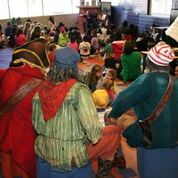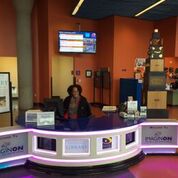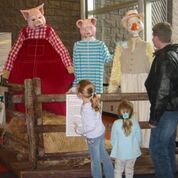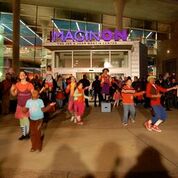Takeaways From a Perfect Library-Theatre Partnership

Photo courtesy of Charlotte Mecklenburg Library
On October 8, 2005, 8,000 people of all ages waited in a line around a city block for a glimpse of ImaginOn: The Joe & Joan Martin Center on opening day. Media, including School Library Journal, covered the ribbon cutting with colorful photographs, vivid predictions, and headlines that challenged readers to “Imagine This!” Then, when the cameras went home, the partners behind ImaginOn were left to figure out how to make the bold promises a reality. Ten years later, the unique collaboration that those partners—Charlotte Mecklenburg Library and Children’s Theatre, both in Charlotte, NC— created still draws attention. The stunning, 102,000-square-foot facility consists of library spaces for children and teens, two state-of-the-art theaters, a multimedia production studio, classrooms, and interactive exhibit spaces. The mission? Bringing stories to life. It was an incredible learning experience to be one of the first staff members shared by the two partners.Solid foundation
The story of ImaginOn began in 1997, when then-library director Bob Cannon met with then-children’s theatre director Bruce LaRowe to explore the idea of sharing a building for youth. A mission statement, plans for a new facility and successful bond vote followed. The founders formed a steering committee comprised of staff and board from each organization, and the partners quickly identified each other's complementary strengths. “At various points in our history, one organization naturally took the lead because it just made sense,” recalls LaRowe. But decisions were always made by consensus. Former library youth services director Melanie Huggins remembers that years before ImaginOn opened, the library and theatre co-presented author visits, plays, and art exhibitions. These early collaborations set the stage, literally as well as figuratively. ImaginOn’s first library manager, Lois Kilkka, recalls, “Even while figuring out the implementation, we had a mission we could explain.” This collaborative spirit became the model for ImaginOn’s first lease and operating agreement.
Children's Theatre actors join a storytime led by author Melinda Long. Photo courtesy of Charlotte Mecklenburg Library
Early challenges
In the excitement of introducing ImaginOn, both the library and the children’s theatre recognized a need to maintain their separate brands and visibility to potential funders as independent organizations. Communication around their different funding and service models was needed as well. The library is mostly publicly funded and offers services for free, while the theatre is an independent non-profit and charges for most programs. Our community had to understand the difference. Other challenges were embedded in organizational operations. To make collaboration work, we all needed to adapt our work styles and expectations. Different planning timelines made some space-sharing procedures in the lease and operating agreement moot. Newly cohabitating employees mingled tentatively, learning the culture of their new colleagues’ profession. No amount of planning could have predicted the adjustments required to do our jobs in a bigger space for larger crowds, while busloads of visitors expected more and more from the highly publicized ImaginOn. Our handful of shared staff responsible for the logistics of integration worked as quickly as possible to achieve a high level of service in positions for which we were creating a new model. Looking back on ten years of operation, we can identify three turning points and lessons learned that may be helpful to others engaged in similar projects.Turning point 1: Cutting out the middleman
The lease and operating agreement specified a shared “partnership and facilities manager,” paid by both organizations, who would oversee four share staff members and coordinate all shared operational and programmatic initiatives. But this structure isolated the daily workings of the partnership from most of the staff, hampering integration efforts. The shared manager position was eliminated, and the library manager and theatre executive director jointly assumed those responsibilities. Through daily, direct communication, ImaginOn’s leadership set a tone for all staff and volunteers for the kind of rapport the partnership needed. The shift was freeing, and staff cross-trained to streamline operations. Small and large integrations began to emerge. The theatre box office handled tickets for busy library programs. Librarians learned to operate sound and light settings. Relationships developed and cooperation expanded to program planning and delivery. The library’s annual distribution of prom dresses for teens now included alterations by costumers. A Harry Potter party featured theatrical effects. Costumed actors dropped by during storytime. Booklists appeared in theatre programs. Shared staff played matchmakers, identifying and facilitating opportunities to work together.Turning point 2: Learning from outside models
Visitors have always seen ImaginOn as one entity—but staff who worked for one organization weren't always prepared to represent the other to the public. Program frequency was another issue. We had to provide more to do, with limited resources. Daily storytimes were filled to capacity. Rehearsals and production work made theatre tours impractical, leaving the theatre invisible to many. There wasn’t enough funding to make theatre teaching artists regularly available free to the public. The computer-based central exhibit was technically challenging, and visitors were frustrated. We set an ambitious goal: every visitor would find a suitable activity within 30 minutes of arrival, every time they came. The solutions came after we borrowed a children’s museum approach.
Our current Welcome Desk was a gift from The Daily Show, broadcast from ImaginOn during the 2012 Democratic National Convention. Photo courtesy of Charlotte Mecklenburg Library
Kilkka and LaRowe introduced a fundamental service philosophy at an all-staff meeting in 2008: Every visitor belongs to all of us. Any staff member would assist any visitor anywhere, anytime. A “welcome desk” in the lobby became a universal first stop and the site for solving general logistical problems. The desk was manned in shifts by all staff—a visible commitment to partnership by both organizations. Because of the welcome desk, everyone stayed informed of all activities and in touch with visitors. Efficient, knowledgeable, consistent customer service throughout the building became the norm. Also, instead of planning unique programs as neighborhood library branches do, we adopted a schedule of recurring programming in thematically predictable “blocks,” filled with a menu of repeating, drop-in programs throughout each day. This suited the visitation patterns of a destination library, and allowed staff the flexibility to adapt programs and incorporate special events. The theatre and library each allocated an annual budget for shared program expenses, such as materials and hourly personnel. We augmented, and ultimately replaced, the computer-based exhibit with self-directed activities and a regular schedule of traveling exhibitions.
Costumes, set pieces, and designs in the lobby intrigue visitors. Photo courtesy of Charlotte Mecklenburg Library
We also brought stage sets and costume pieces into the lobby, and invited visitors “behind the curtain” to explore stagecraft through interactive displays. The exposure became a valuable marketing tool for theatre ticket sales.Turning point 3: The economic crash
The national economic crisis of 2008–2009 tested the partnership. The theatre was hit first, as ticket sales and donations lagged. In 2010, public library funding was slashed; operating hours were reduced. Library and theatre staff felt a great deal of uncertainty when a community task force was created to make recommendations for the future of the library. However, that group ultimately acknowledged that ImaginOn was a unique asset, one that should be preserved and celebrated. Shared positions were reduced but not eliminated, and as Kilkka remembers, “What’s remarkable is that both organizations continued to contribute.” With fundamental commitment to the partnership a demonstrated priority, the years after the downturn created opportunity and renewed focus. LaRowe recalls, “We had really thoughtful people on board, and commitment to the partnership became a hiring criteria.” The library and theatre realigned resources with organizational priorities during the downturn, and as the economy recovered, both emerged with clear goals, prepared to grow individually and together.Now…and next
ImaginOn is entering its second decade. The partnership is healthy, and a revised lease and operating agreement is in place to keep it so. Today, a new generation of leadership— library manager Jason Hyatt and children’s theatre executive director Hannah Grannemann—is at the helm.
ImaginOn is at the heart of Charlotte’s cultural life. Photo courtesy of Charlotte Mecklenburg Library
The next challenge is to develop ImaginOn’s relationships with other entities, and leverage enthusiasm for the partnership to reach ever-widening communities. For example, a new park and university building have opened across the street. Hyatt and Grannemann have initiated a relationship with the Department of Parks and Recreation, and will provide programs and performances in the park to more deeply position ImaginOn as a focal point of Charlotte’s growing cultural district. With ImaginOn’s internal partnership securely established, both organizations can pursue new relationships together. ImaginOn’s staff and leadership identified areas of overlap in the two organizations' strategic plans, and the partnership is building on those shared priorities this year. Broader professional development opportunities are coming to fruition as well, such as training in theatrical techniques for interested librarians. In exchange, librarians help teaching artists incorporate literacy skills into programs. Plus, there is discussion about trending titles and how these can inform each season’s productions. As library CEO Lee Keesler puts it, "One plus one equals three."Lessons Learned by Bruce LaRowe and Lois Kilkka
- Recognize and maximize the relative strengths of each organization.
- Have patience. With more people involved, decisions take more time.
- Consider individual decisions through the lens of the partner.
- See compromise as the creation of a win-win environment.
- There will be good times and difficult times. Stay committed.
- Be vulnerable. Assumptions will be challenged. Embrace partnership as a catalyst for growth that will lead places you never dreamed possible.
RELATED
The job outlook in 2030: Librarians will be in demand
The job outlook in 2030: Librarians will be in demand
ALREADY A SUBSCRIBER? LOG IN
We are currently offering this content for free. Sign up now to activate your personal profile, where you can save articles for future viewing






Add Comment :-
Comment Policy:
Comment should not be empty !!!
Teresa K. Cain
I, too, am very honored to have been a founding staff member of ImaginOn. It was an amazing experience -- I had so many opportunities to serve customers in very unique ways. One of the goals I set for myself was to provide experiences to customers that would create memories that would last a lifetime. Of course having a world-class facility helped me meet that goal; however, the collaborations with other organizations were the deciding factor. I found that by working with various partners, I was able to provide services for customers that I could only have dreamed of doing by acting alone.Posted : Apr 06, 2016 12:53